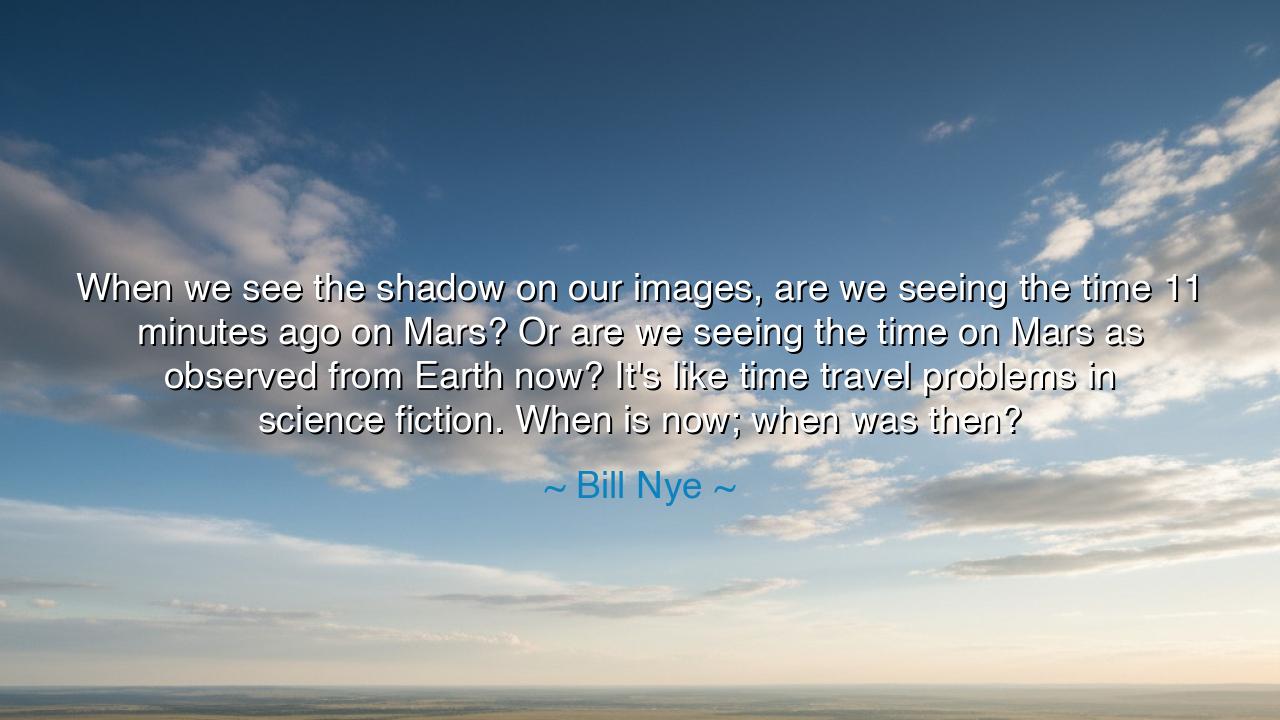
When we see the shadow on our images, are we seeing the time 11
When we see the shadow on our images, are we seeing the time 11 minutes ago on Mars? Or are we seeing the time on Mars as observed from Earth now? It's like time travel problems in science fiction. When is now; when was then?






In the words of Bill Nye: “When we see the shadow on our images, are we seeing the time 11 minutes ago on Mars? Or are we seeing the time on Mars as observed from Earth now? It's like time travel problems in science fiction. When is now; when was then?” At first glance, this sounds like a riddle of science, a puzzle about light and planets. Yet within it is hidden one of the most ancient and profound questions of humankind: the mystery of time. For time is not a simple thread, but a fabric woven with distance, perception, and memory.
To understand this, we must first recall that the light from Mars takes many minutes to reach our eyes or our machines. When we gaze at its deserts or its moons, we are not seeing Mars now, but Mars then—as it was eleven minutes ago. The same is true of the stars: the light of Sirius left its blazing heart years ago, the light of Andromeda departed more than two million years past. When we lift our eyes to the heavens, we are beholding the ghosts of time, the past shining into our present. Nye’s words remind us of this paradox: that our “now” is always mixed with “then.”
The ancients, too, grappled with this enigma. Heraclitus declared that all is flux, that we never step into the same river twice. Augustine of Hippo pondered endlessly, asking: What is time? If no one asks me, I know, he said. But if I am asked to explain, I do not. From their meditations to our modern science, the same truth emerges: time is not what it seems. What we call the present is already past in some sense, and what we call the past still lives in the beams of light traveling toward us across the void.
This puzzle of “when is now; when was then” is not merely a curiosity of astronomy. It is a mirror for human life itself. For when we remember a moment from childhood, we are also traveling in time, revisiting a version of ourselves that no longer exists but still lingers in the corridors of the mind. When we tell a story from history, the lives of those long dead become present to us again, as real in our minds as the people we walk beside today. Just as the stars shine with ancient light, so do our memories and traditions shine with the radiance of the past.
Consider the example of the astronomer Galileo Galilei, who looked through his telescope and saw the moons of Jupiter. Yet he was not seeing them as they were in his moment of observation, but as they had been moments before. Still, from that imperfect “then,” he unlocked truths that reshaped humanity’s vision of the cosmos. In this we learn that though time may delay, and perception may deceive, wisdom can still be drawn from the echoes of the past. We need not despair that we cannot see things as they are “now”—we can still learn, still grow, still be transformed by the lights of “then.”
Nye also compares this to the riddles of science fiction, where travelers wonder if they are stepping into the past or the future, and whether a single moment can split into many. In truth, this is no mere fantasy. Einstein himself showed us that time bends, that it flows differently depending on speed and gravity. To approach the speed of light is to step closer to the domain of the timeless. Thus, the questions of philosophers and storytellers are now the questions of physicists, and the riddles of the imagination may one day become the maps of exploration.
The lesson, then, is both cosmic and personal. Time is not absolute. It bends, it stretches, it hides within distance and memory. We must live with the humility of knowing that what we see is not always the truth of the moment, and yet we must also live with the courage of knowing that even imperfect glimpses can guide us. Just as we look at Mars and see its past, so others may look upon us and learn from our own “then.” Our deeds, our words, our stories, may shine far into the future like light crossing the stars.
In practice, let us honor both the present and the past. Be patient with the delays of life, for what seems far away may yet teach us. Treasure your memories, for they are light still reaching you from long ago. And when you act, act with greatness, knowing that what you do today will echo far beyond your own “now.” For as Nye reminds us, the riddle of time is not just a question for scientists, but a guide for all who wish to live with wisdom: to ask always, with reverence and wonder, When is now? When was then?






AAdministratorAdministrator
Welcome, honored guests. Please leave a comment, we will respond soon